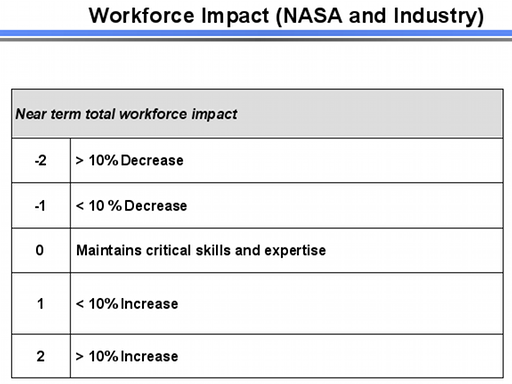« Reading List: The Apollo 11 Moon Landing |
Main
| Mozilla Thunderbird "Domain Name Mismatch": Explanation and Work-Around »
Sunday, August 16, 2009
It's official! NASA is a jobs program.
I've been listening to an audio recording of the most recent public meeting of the
Review of U.S. Human Space Flight Plans Committee (Augustine Commission), held on August 12th, 2009 in Washington, D.C. This is scheduled to be the last public meeting before the final report is issued, although there is an option for another public session should one prove necessary. In the instant meeting, several “
integrated options” (PPT) were presented, then a budget and schedule analysis was done for each under various funding assumptions, and the options ranked according to twelve criteria ranging from crew safety and mission success to expanding human civilisation beyond the Earth.
Wanda Austin presented the “
Evaluation Measures and Criteria” (PPT) to be used in this ranking. The last of these was titled “Workforce Impact (NASA and Industry)”, slide 16 in the presentation, which appears below (I've cropped and scaled the slide to fit on the page, but nothing other than the slide number has been elided).

As I was listening to the audio of the presentation, I happened to be walking rather briskly in increasingly intense rain in the hope of outrunning an approaching thunderstorm, but I almost tripped over my jaw when I heard the discussion of this slide. Now, “critical skills”, “industrial base”, and “workforce retention” have been frequently-mentioned items in the committee's deliberations to date, so I suppose I should have seen this coming, but it's still one of the starkest illustrations I've encountered why government programs and NASA in particular will never accomplish the goal of making humans a spacefaring species.
It's been a commonplace observation for decades that a principal reason access to space is so horrifically expensive is that the way NASA and other government programs go about it requires a “standing army” of tens of thousands of civil servants and contractor employees who have to be paid regardless of the flight rate. This creates a huge fixed cost component in the operations budget, which cannot be reduced by economising on hardware costs or launching more frequently. Consequently, most “new space” concepts, including my own
modest proposal from 1993, have focussed on reducing the size of the standing army to a bare minimum. If a crew of just a few people could launch a liquid-fuelled ICBM in the 1960s, why should it take thousands of people to operate space vehicles today, especially given the progress in computing and automation made in the intervening years?
Well, here's the answer—because NASA is a
jobs program, not a space program! Its purpose is to employ civil servants and industry contractor personnel, carefully spread around congressional districts and pouring taxpayer funds into their economies. Look at how the Augustine Commission is scoring the various options they're evaluating on their consequences for the workforce. In these criteria, a higher number is good; a lower number is bad. So the
best possible outcome for an option is if it
increases the size of the standing army by more than 10%, and it is considered the worst possible demerit if it shrinks the standing army by greater than 10%!
Is it any wonder that
all of the options presented in the “
Scenario Affordability Analysis” (PPT) by Sally Ride have huge operational costs on the right side, even after all the design, development, test, and evaluation work is completed? Consequently, any option which scores highly on the “Workforce Impact” criterion will
necessarily result in a program which employs a vast number of people to permit a handful of civil servants to fly in space infrequently. This may seem counterproductive if you believe that NASA's mission is the exploration and expansion of the human presence into space, but for a jobs program, it's “mission accomplished”.
Posted at August 16, 2009 17:10
